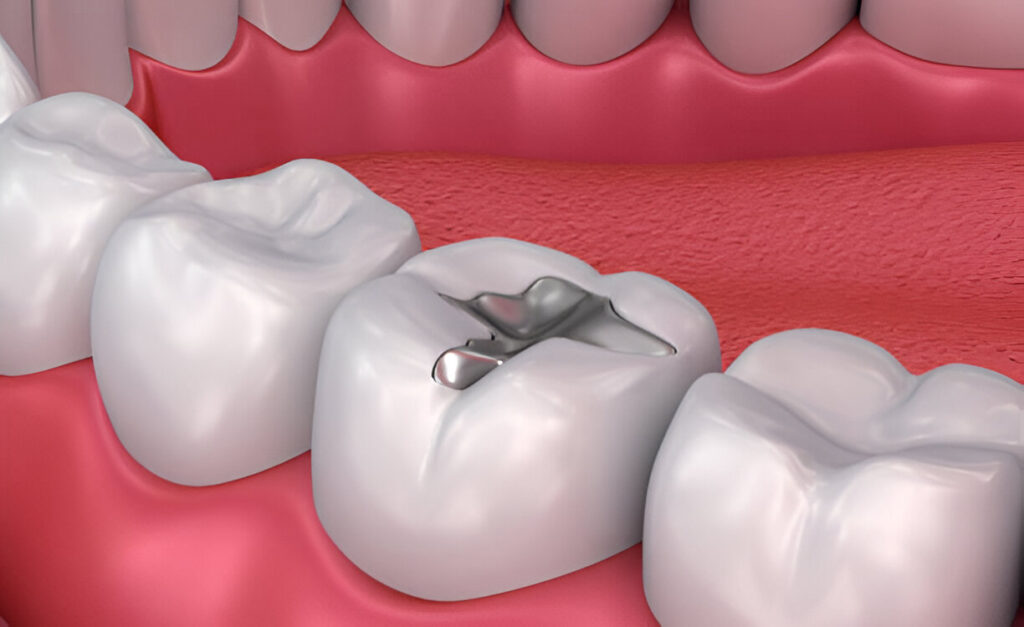Dental fillings help repair cavities and restore damaged teeth. They protect the tooth from further decay and maintain its function. However, fillings do not last forever. Their lifespan depends on several factors, including the type of material used, oral hygiene, and daily habits.
This article explores how long different types of fillings last, what affects their longevity, signs that indicate a filling needs replacement, and tips to extend their lifespan at a Polyclinic in Dubai.
How Long Do Different Types of Fillings Last?
The durability of a Dental filling depends on the material used. Below is an overview of the most common types and their average lifespan.
1. Amalgam Fillings (Silver Fillings) – 10 to 15 Years
Amalgam fillings are made from a mixture of metals, including silver, mercury, tin, and copper. They are one of the strongest filling materials available and are often used for molars, where chewing pressure is the highest.
These fillings are durable and resistant to wear. However, they can expand and contract with temperature changes, which may weaken the tooth over time.
What is the Difference Between a Cap and a Crown?
2. Composite Fillings (White Fillings) – 5 to 10 Years
Composite fillings are made from a blend of plastic and ceramic materials. They are popular because they match the natural tooth colour, making them ideal for front teeth.
While composite fillings offer aesthetic benefits, they are less durable than amalgam fillings. They may wear down faster, especially if used on molars.
3. Gold Fillings – 15 to 30 Years
Gold fillings are made from a gold alloy, making them highly durable and resistant to wear. Although they are expensive, they can last for decades with proper care.
Unlike other fillings, gold fillings do not corrode, making them a long-lasting option. However, they are highly visible and may not be suitable for those who prefer a natural appearance.
4. Ceramic Fillings – 10 to 15 Years
Ceramic fillings, made from porcelain, are a durable and aesthetic choice. They resist staining and provide a natural look. However, they are more fragile than metal fillings and may chip if subjected to excessive force.
5. Glass Ionomer Fillings – 5 to 7 Years
Glass ionomer fillings are made from a mixture of glass and acrylic. They are often used for small cavities, especially in children’s teeth. These fillings release fluoride, which helps prevent further decay, but they are not as strong as other materials.
Can I Just Walk in to a Polyclinic?
Factors That Affect How Long Fillings Last
Several factors influence the lifespan of dental fillings.
1. Oral Hygiene
Good oral hygiene is crucial in maintaining fillings. Brushing twice a day and flossing regularly helps prevent plaque build-up, which can cause decay around the filling.
2. Diet and Eating Habits
Hard and sticky foods can damage fillings. Chewing on hard foods like ice, nuts, or boiled sweets can cause fillings to crack. Sticky foods, such as caramel and chewing gum, may loosen fillings over time.
3. Teeth Grinding (Bruxism)
Grinding or clenching teeth puts extra pressure on fillings, causing them to wear down faster. A dentist may recommend a night guard to protect teeth from excessive grinding.
4. Location of the Filling
Fillings placed on molars, which bear the most chewing pressure, tend to wear out faster than those on front teeth. Larger fillings also have a shorter lifespan than smaller ones.
5. Regular Dental Check-Ups
Routine dental check-ups help monitor the condition of fillings. A dentist can check for cracks, decay, or gaps around the filling and replace it before further damage occurs.
Can a Normal Dentist Do Crowns?
Signs That a Filling Needs Replacement
Over time, fillings may wear down or become damaged. It is important to watch for signs that indicate a replacement is needed.
1. Cracks or Chips
If a filling cracks or chips, bacteria can enter the tooth and cause decay. This may lead to pain or sensitivity.
2. Tooth Sensitivity
Increased sensitivity to hot, cold, or sweet foods may indicate that the filling is wearing out or is no longer properly sealed.
3. Pain While Chewing
If biting or chewing causes discomfort, the filling may have shifted or become loose.
4. Discolouration or Stains
Composite fillings may become stained over time. While this is usually a cosmetic issue, it may also indicate wear and tear.
5. Gaps Around the Filling
If there is a visible gap between the filling and the tooth, bacteria can enter and cause decay.
Can I Just Collect Medicine from a Polyclinic?
How to Make Fillings Last Longer
While fillings do not last forever, proper care can help extend their lifespan.
1. Maintain Good Oral Hygiene
Brushing with fluoride toothpaste and flossing daily can help prevent decay around the filling.
2. Avoid Hard and Sticky Foods
Limiting hard and sticky foods can prevent fillings from cracking or loosening.
3. Visit the Dentist Regularly
Routine check-ups help detect any problems with fillings early on.
4. Wear a Mouth Guard
If you grind your teeth, a mouth guard can help protect fillings from excessive pressure.
5. Use a Fluoride Mouthwash
Fluoride strengthens tooth enamel and can help prevent decay around fillings.
Alternatives to Traditional Fillings
If a filling is not suitable, other treatments may be recommended.
1. Dental Crowns
For large cavities or weak teeth, a crown may be placed over the tooth to provide protection and support.
2. Inlays and Onlays
These custom-made restorations fit into or onto the tooth, offering a durable alternative to fillings.
3. Silver Diamine Fluoride (SDF)
This is a non-invasive treatment that helps slow down tooth decay and may prevent the need for a filling.
4. Root Canal Treatment
In cases of severe decay, a root canal may be necessary to save the tooth.
Conclusion
Fillings are an effective way to restore damaged teeth, but they do not last forever. Their lifespan depends on the material used, oral hygiene, eating habits, and dental care. Recognising signs of wear and taking proper care of fillings can help them last longer. Regular dental check-ups are essential for maintaining good oral health and ensuring that fillings remain in good condition.
FAQs About Fillings
Can a filling last a lifetime?
No, fillings eventually wear out and need replacing. However, gold fillings can last over 30 years with good care.
What happens if a filling falls out?
If a filling falls out, see a dentist as soon as possible. Leaving the tooth unprotected can lead to further decay or infection.
Are white fillings better than silver ones?
White (composite) fillings look more natural but are less durable than silver (amalgam) fillings. The best choice depends on the location of the filling.
Can I eat after getting a filling?
If you had a composite filling, you can eat immediately. If you had an amalgam filling, wait at least 24 hours before chewing on that side.
Does replacing a filling hurt?
No, the procedure is usually painless. A dentist may numb the area before removing and replacing the old filling.





